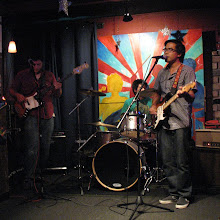One of the coolest things about recording technology today is the ability to record basically anywhere there is access to electrical power. Location recording was of course possible ever since the start of sound recording, but in terms of quickness of setup, ease of use, and overall quality achievable, modern digital recording is without parallel.
On Saturday evening, Chris Lynch who performs under the stage moniker "Brother Cecil" came by to hang out with myself and my girlfriend. Along with him came a guitar and a tambourine, which he quickly brought out to show me some tunes that he has been working on. We had been talking about getting a recording of his music together for a long time, and so we thought of doing a test run of his songs while he was over.
I have heard him play many times over the years that we have known each other, but have never tried to attempt to record him. Brother Cecil's music is very reminiscent of classic southern acoustic blues, mixed in with his garage rock and roll singing style (a la Roky Erickson of 13th Floor Elevators fame), so both him and I felt capturing a certain energy and creating a mood with the recording was a little bit more important than capturing pristine audio quality.
After taking a seat at my dinner table, I began to setup my mics, much to his surprise.
"We're going to record here?" He asked.
I responded with a, "Why not?"
So within about 5 minutes, the mics, the interface, computer and recording levels were all set. At first we used my two AT2020s set at the same distance from Chris, one pointing more to his mouth, and the other pointing down to his guitar, roughly at the sound hole. Normally I would not mic a guitar at the sound hole because of the boomy sound that normally emanates from the guitar at the sound hole, but given the distance of the mic and the microphone's position above the guitar, I didn't worry too much about proximity effect or boominess. I also placed both mics at the same point to avoid phasing and comb filtering between the two microphones.
Two SM57 in a coincident pair. Note one microphone is biased towards voice, while the other is biased towards the guitar.
The two AT2020s worked fine as they always do, yielding a very open, clear and crisp recording of both his voice and guitar, but we both agreed that it sounded a little too clean for his style of music. I then replaced the AT2020's with Shure SM57's set in a similar fashion, though slightly closer due to my M-Audio Fastrack 8R's relative lack of gain in the mic preamp. The sound of the SM57s was not as bright, a little furry, and a little ragged in comparison as to be expected, which served Chris's style much better. The SM57s however still captured a surprisingly open sound, possibly reflections coming off the walls of my kitchen, especially the wall directly behind him. Though of course again this was not an ideal recording environment, it was fun how impromtu the session was, and was a neat experiment in environmental recording.







